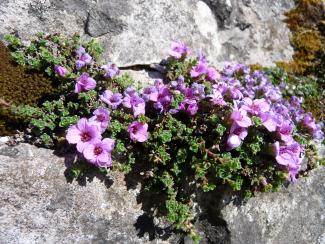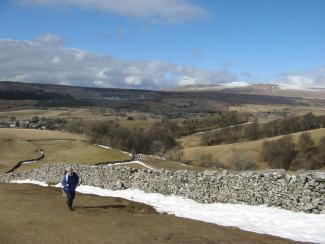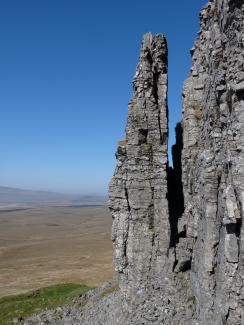Coronavirus regulations scupper an annual treat.
 One of the highlights of each year is my annual trip to Penyghent to pay homage to the purple saxifrage. This rare plant has been growing on Penyghent from time immemorial - a relic of the ice age. The main display is on the limestone on the Northern aspect of the hill at about the 2000ft contour but there are one or two plants on the Southern flank – if you know where to look for them. Bees have undertaken the hike in years gone by, most recently in 2016, but have always ascended from the Northern slopes where the going is somewhat easier but my preferred route is from Brakenbottom up the ‘sharp end’ so that a circular route can be followed over the summit and both sites visited.
One of the highlights of each year is my annual trip to Penyghent to pay homage to the purple saxifrage. This rare plant has been growing on Penyghent from time immemorial - a relic of the ice age. The main display is on the limestone on the Northern aspect of the hill at about the 2000ft contour but there are one or two plants on the Southern flank – if you know where to look for them. Bees have undertaken the hike in years gone by, most recently in 2016, but have always ascended from the Northern slopes where the going is somewhat easier but my preferred route is from Brakenbottom up the ‘sharp end’ so that a circular route can be followed over the summit and both sites visited.
 The hike up the first field when leaving the lane which runs past Horton-in-Ribblesdale school always seems to be a real pull but walking becomes easier for a while after reaching a level stretch and getting a second wind. On a good day views start to develop and a glance back as Ingleborough appears offers the opportunity to catch a breath. There is the possibility of a meadow pipit or two and if there are meadow pipits there is always a chance of a merlin on these lower slopes (although I’ve never seen one!). On the higher slopes we have chance of a Raven and if we’re lucky we may come across a Ring Ouzel as I did some years ago.
The hike up the first field when leaving the lane which runs past Horton-in-Ribblesdale school always seems to be a real pull but walking becomes easier for a while after reaching a level stretch and getting a second wind. On a good day views start to develop and a glance back as Ingleborough appears offers the opportunity to catch a breath. There is the possibility of a meadow pipit or two and if there are meadow pipits there is always a chance of a merlin on these lower slopes (although I’ve never seen one!). On the higher slopes we have chance of a Raven and if we’re lucky we may come across a Ring Ouzel as I did some years ago.
The great bulk of the hill looming ahead can be something of a daunting sight but a steady pace gets us to the final stile where we join the Pennine Way before the real climbing begins. Level ground is reached when limestone is found again at around 2000ft and a careful step off the path should reveal the first sighting of our target plant – the purple saxifrage. There is a fine photograph on page 180 of Flora Britannica showing the plant and a view down the ridge.

A final push gets us to the top of the cliff and onto the recently-flagged path to the summit. This path, made from stone flags recovered from old mill sites and flown in by helicopter, is a fine example of recycling and a testament to the skill of the construction team that laid it.
The view from the summit can be extensive or elusive. On a fine day the panorama includes the other hills of the Three Peaks, Ingleborough and Whernside, Morecambe Bay and the Mountains of the Lakes, Pendle Hill, Emley Moor TV mast, Fountains Fell and the hills of the dales. On a poor day visibility can be nil, or close to it, as shown in the photo of my companions when we reached the trig point in April 2013. On that day the summit was covered in sheet ice and was considered too dangerous to continue and we retraced our steps down the Southern flank. Fortunately we had managed to see the saxifrage on our ascent.
Hopefully on this walk the virtual weather will allow us to continue onwards towards our main destination down another recently-flagged path as impressive as the one on the ascent. The saxifrage comes into flower at roughly the same time each year (end March-early to mid April), and seems to be largely unaffected by the severity or otherwise of the winter but the weather on the day of a visit can be anything from freezing cold to balmy sunshine as it was in 2012 when early butterflies and bees were attracted to the flowers; there was also a pair of pied wagtails enjoying the Spring sunshine.
Leaving the path to get near to the cliffs that support the saxifrage affords a view of a mostly-unseen feature of Penyghent, the 60ft-high limestone pinnacle.
It’s all downhill from here on and if the weather and time allow we could take a detour to see what’s happening at Hunt Pot and Hull Pot where a few other early plants may be found. There’s always a chance of a dipper starting to nest beneath the stream outlet in Hull Pot or a wren exploring the area and an odd primrose might be found in a sheltered nook or cranny whilst blue mountain grass and hare’s tail cotton grass should also be about.
 So, following Horton Scar Lane back to Horton, we arrive back at our starting point and as both the pubs and the cafe are closed because of the Coronavirus we’ll have to partake of whatever we’ve brought with us to round off a perfect day.
So, following Horton Scar Lane back to Horton, we arrive back at our starting point and as both the pubs and the cafe are closed because of the Coronavirus we’ll have to partake of whatever we’ve brought with us to round off a perfect day.
Let’s hope that in the not-too-distant future we can enjoy the walk in reality but in the meantime I hope that you’ve enjoyed this virtual trip.
Stuart
